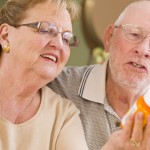With new figures released today showing a vitamin D deficiency in 23% of the adult population, the National Osteoporosis Society is issuing a timely reminder to get out and soak up the benefits of sunshine.
The charity’s annual Sunlight Campaign urges people to get safe sun exposure every day between May and September to keep their vitamin D levels topped up to boost their bone health.
Claire Severgnini, Chief Executive, for the National Osteoporosis Society said: “The Sunlight Campaign is all about raising awareness of vitamin D and its importance for bone health. We want to give clear advice about how to achieve this natural health boost safely so that people can be confident about going outdoors and getting the sun exposure they need without burning and damaging their skin.”
New national guidance from the National Institute for Health and Care Excellence (NICE) Centre for Public Health has confirmed vitamin D deficiency is a concern with 1 in 5 adults being vitamin D deficient. This is supported by data released today from the National Diet and Nutrition Survey* (NDNS) confirming evidence of an increased risk of vitamin D deficiency in both adults and children. Public Health England remind us how important it is for people to build strong bones by getting enough vitamin D.
Across the UK from May to September our bodies soak up sunshine and turn it into vitamin D, which is essential for strong bones. As sunlight is the best natural source of vitamin D, getting outside for a few minutes each day will give your bones the boost they need to stay strong and help prevent osteoporosis.
Just 10 minutes once or twice a day between 11am and 3pm with bare arms and legs with no sunscreen is enough for most of us to top up our vitamin D levels to last us through the winter. But always take care not to burn.
Dr Alison Tedstone, Chief Nutritionist and Director of Diet and Obesity at Public Health England (PHE), said: “I am delighted to see the launch of this campaign which highlights the importance of getting enough vitamin D from the sun. Most people can get all the vitamin D they need by exposing their skin to summer sunlight for short periods, taking care to cover up or protect their skin before it burns. In line with government advice, PHE recommends that people who are unable to get enough sun, as well as infants and young children aged six months to five years, pregnant and breastfeeding women, and people over 65 years, take a daily vitamin D supplement to prevent deficiency.”
The National Osteoporosis Society’s 2014 Sunlight Campaign is featured on our website www.nos.org.uk/vitamind with clear and simple advice on getting the best free vitamin D from the sun and other sources of vitamin D for people who aren’t able to get outdoors enough.
DID YOU KNOW?
• If your shadow is shorter than you, the sun is at the right angle to produce vitamin D.
• If your skin starts to burn, your body will begin to deplete the vitamin D that it has produced so safe sun is always best.
• Only about 10% of our vitamin D comes from food.
Key Messages for the 2014 Sunlight Campaign:
1. Sunlight is the best natural source of vitamin D. Vitamin D helps our bodies to process calcium effectively and is essential for healthy bones.
2. Exposure to sunlight every day between May and September will increase vitamin D and help to keep bones healthy.
3. You should try to get 10 minutes of sun exposure to your bare skin, once or twice a day (depending on skin type), without sunscreen and taking care not to burn.
4. Always take care not to burn, especially during the strong sunshine in the middle of the day.
5. Even on cloudy days, your body can still produce vitamin D from sunlight but it can take a little longer.
6. Get outside between May and September so that your body can produce enough vitamin D to help see you through the winter months.
7. Make sure that you are actually outside. Your body cannot produce vitamin D even if you are sitting by a window or in a conservatory on a sunny day. You must be outside.
8. Try and include vitamin D rich foods in your diet, such as oily fish and eggs. Many margarines, breakfast cereals and dairy alternatives are fortified, but do check the label.
9. If you are 65+ years, not exposed to much sun (e.g. housebound or cover-up for cultural reasons) or a pregnant or breast-feeding woman, you should consider taking a daily, 10 micrograms (400IU), vitamin D supplement.





